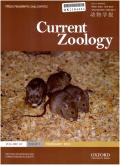同步打哈欠:马匹社会凝聚力的意义
IF 2
2区 生物学
Q2 ZOOLOGY
引用次数: 0
摘要
迄今为止,人们对自发性打哈欠(SY)和传染性打哈欠(CY)的研究主要集中在几个类群,尤其是灵长类动物。在这里,我们重点研究了马的自发性打哈欠和传染性打哈欠。马是一个合适的物种,因为它们具有复杂的社会动态,而在这些现象的研究中,马在很大程度上被忽视了。通过分析 48 匹马在牧场上打哈欠的视频,我们确定了两种打哈欠形态:盖牙(YCT)和露齿(YUCT)。我们使用 EquiFACS 定量证明了 YCT 和 YUCT 在肌肉募集方面的不同。此外,通过比较咀嚼-打哈欠-咀嚼与咀嚼-咀嚼-咀嚼这两种不同条件,我们首次提供了 CY 存在的证据。在我们的母马中,人际关系良好的受试者的 CY 更为突出,这支持了社交调节假说。此外,与非亲缘关系的母马相比,亲缘关系的母马对亲缘关系的打哈欠反应更快,而经常梳理彼此的亲缘关系的母马对彼此的打哈欠反应更快。熟人打哈欠的高敏感性可提供选择性优势,提高行为同步性和群体凝聚力。本文章由计算机程序翻译,如有差异,请以英文原文为准。
Yawning In Sync: Implications For Social Cohesion In Horses
The increasing interest in the study of spontaneous (SY) and contagious yawning (CY) was so far focussed on several taxa, especially primates. Here, we focused on SY and CY in horses, a suitable species due to their complex social dynamics that has been largely overlooked in research on these phenomena. By analysing videos of 48 horses on pasture, we identified two yawning morphologies: Covered (YCT) and Uncovered Teeth (YUCT). Using EquiFACS, we quantitatively demonstrated that YCT and YUCT differ in terms of muscle recruitment. Moreover, we provide the first evidence for the presence of CY by comparing two different conditions: chewing-yawn-chewing versus chewing-chewing-chewing. Supporting the Social Modulation hypothesis, in our mares, CY was more prominent among subjects sharing good relationships. Moreover, subjects responded more rapidly to kin compared to non-kin and kin frequently grooming each other responded even more rapidly to each other yawns. The high familiar yawn sensitivity can provide selective advantages increasing behavioural synchronization and group cohesion.
求助全文
通过发布文献求助,成功后即可免费获取论文全文。
去求助
来源期刊

Current Zoology
Agricultural and Biological Sciences-Animal Science and Zoology
CiteScore
3.20
自引率
9.10%
发文量
111
审稿时长
6 weeks
期刊介绍:
About the Journal
Current Zoology (formerly Acta Zoologica Sinica, founded in 1935) is an open access, bimonthly, peer-reviewed international journal of zoology. It publishes review articles and research papers in the fields of ecology, evolution and behaviour.
Current Zoology is sponsored by Institute of Zoology, Chinese Academy of Sciences, along with the China Zoological Society.
 求助内容:
求助内容: 应助结果提醒方式:
应助结果提醒方式:


